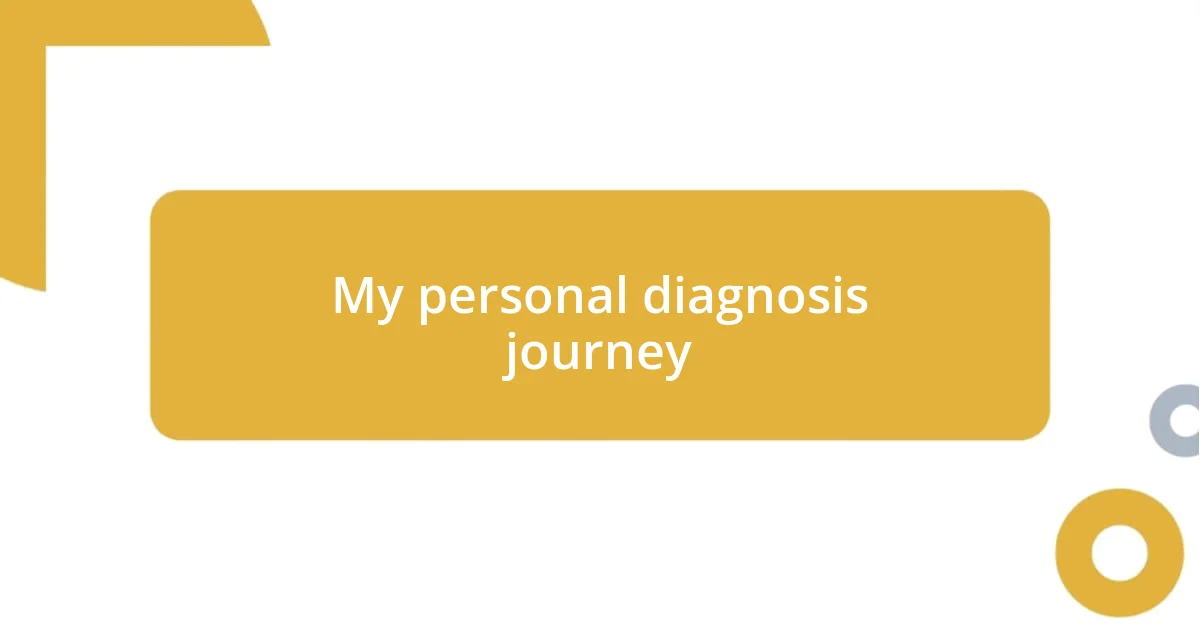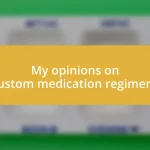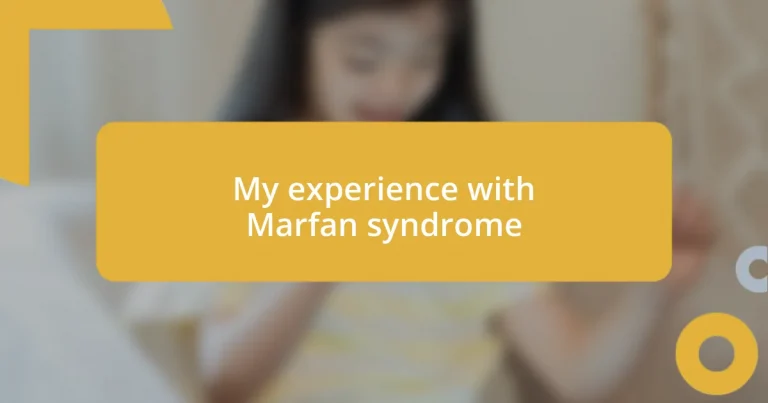Key takeaways:
- Understanding Marfan syndrome involves recognizing diverse symptoms, such as tall stature and flexible joints, which can manifest uniquely in each individual.
- The diagnosis journey includes navigating emotions, seeking specialist consultations, and relying on family support for awareness and resilience.
- Connecting with support groups and utilizing reliable resources, like the Marfan Foundation, enriches personal experiences and promotes advocacy and education about the condition.

Understanding Marfan syndrome
Understanding Marfan syndrome is a complex journey that often begins with a family history of the condition. When I first learned I had it, the weight of uncertainty settled on my shoulders. How could something invisible feel so tangible in my everyday life?
As I navigated my diagnosis, I found that Marfan syndrome affects connective tissues, which are the body’s structural support system. I remember feeling overwhelmed by the idea that this seemingly benign condition could impact everything from my height to my heart. It’s not just a label; it can shape your life in ways you might never expect.
I’ve often met others with Marfan, and our stories vary wildly, which can be both comforting and confusing. While some share experiences of physical challenges, like the time I struggled with sudden fatigue during a simple hike, others might mention their triumphs over adversity. Isn’t it fascinating how one condition can manifest in such a diverse array of symptoms and experiences?

Recognizing Marfan syndrome symptoms
When it comes to recognizing Marfan syndrome symptoms, I’ve learned that they can often be subtle but impactful. For me, it started with my height—being taller than my peers made me stand out, but it wasn’t something I thought much about until I began to notice other clues. I noticed that my flexible joints often led to awkward moments in sports, but it took time before these strange occurrences connected in my mind to something more significant.
Here are some symptoms that might indicate Marfan syndrome:
- Tall and slender build
- Long arms, legs, fingers, and toes
- Hyperflexible joints
- Scoliosis (curvature of the spine)
- Eye problems, such as lens dislocation
- Heart issues, including enlarged aorta
Understanding these symptoms can take time and may vary from person to person, reminding me that Marfan syndrome is deeply individual. I remember how a friend pointed out something I had dismissed during casual conversations; noticing others offering their observations helped me see that not every clue was insignificant. Each symptom is a piece of a larger puzzle, and piecing them together can be a pivotal step toward clarity and care.

My personal diagnosis journey
I still remember that moment when my doctor looked me in the eye and mentioned Marfan syndrome. It felt surreal. The words reverberated in my mind like a drum, amplifying my fears and uncertainties. I had done my research prior, but hearing it directly, I felt both a relief and an overwhelming surge of confusion. It was as if I had been handed a ticket for a ride I never wanted to take, yet I was already on board.
As I delved into my diagnosis, I consulted with numerous specialists. Each appointment felt like piecing together a jigsaw puzzle; some days, I could see only a few fragments, while other days, the bigger picture began to emerge. I recall one consultation when a geneticist patiently explained how my body’s connective tissues functioned differently because of Marfan. It clicked for me then: I wasn’t just unusually tall; I was part of a complex narrative that connected me to countless others.
While navigating the emotional landscape of my diagnosis was challenging, I often leaned on my family for support. Their reactions ranged from concern to confusion, echoing my own feelings. “How do we move forward?”, they asked. I assured them it was about finding the right balance of awareness and action. I realized that my journey toward understanding didn’t just impact me; it shaped how my loved ones viewed health, identity, and resilience.
| Aspect | Details |
|---|---|
| Initial Reactions | Confusion and relief upon diagnosis |
| Doctor Consultations | Piece by piece understanding of the condition |
| Family Support | Shared journey influencing emotional dynamics |

Living with Marfan syndrome daily
Living with Marfan syndrome daily can feel like constantly adapting to a fluctuating landscape. Some days, my long limbs and flexible joints serve me well, like when I reach for the top shelf without a second thought. Yet, on other days, I find myself pacing myself during activities, feeling the strain in my heart or muscles as a reminder of my limitations. It’s a strange balance between embracing my abilities and acknowledging my boundaries.
I often reflect on how my routine has been shaped by this condition. Simple tasks, like tying my shoes, can require more concentration than I’d like to admit. I remember a day at the park when I decided to play catch with friends; the joyous laughter quickly turned into concern as I felt my heart racing more than usual. Have you ever had those moments where you’re forced to step back and reassess your capabilities? In those instances, I’ve learned to tune into my body’s signals—listening carefully can be a powerful tool for staying safe.
Maintaining a daily routine isn’t just about physical activity; it’s also about being proactive with health management. I make sure to keep regular appointments with my cardiologist to monitor my heart health. Each visit feels both reassuring and nerve-wracking; sharing updates with my doctor about my daily experiences reveals how intertwined my routines and well-being truly are. How does one navigate the duality of living with a visible condition while requiring internal vigilance? For me, it’s the balance of living fully while keeping the complexities of Marfan syndrome in mind that helps me stay grounded.

Managing health challenges effectively
Managing the health challenges that come with Marfan syndrome requires a multifaceted approach. One of my most valuable strategies has been establishing a routine for regular check-ups and tracking my symptoms. During one hectic summer, I almost skipped my biannual echocardiogram, thinking I felt fine. The moment my cardiologist reviewed my results, I realized how crucial those appointments are. It’s all too easy to overlook maintenance, but my health can change in the blink of an eye.
I’ve also found that educating myself about Marfan syndrome empowers me to advocate for my health. Once, at a family gathering, I overheard a relative mislabel my fatigue as laziness. It stung a bit, but it sparked a conversation that led to them understanding the condition better. Have you ever had moments when others just didn’t “get” what you’re dealing with? I’ve learned the importance of sharing my experiences openly, transforming misunderstandings into opportunities for awareness.
Interestingly, I discovered that having a strong support network is vital. Connecting with others who share my journey through support groups has been enriching. I still recall a night when I attended an online meeting and shared my struggles with anxiety. Hearing others share similar experiences made me feel less isolated. It’s amazing how common threads knit individuals together, reinforcing that I’m not alone in this, and that collective strength can be a beacon during tough times.

Connecting with support groups
Connecting with support groups has been a transformative experience for me. I vividly remember my first meeting—it felt like stepping into a warm embrace of understanding. Sharing my frustrations and breakthroughs with those who truly grasp the nuances of Marfan syndrome made me feel less like an outsider. Have you ever felt that sense of relief when speaking to someone who just gets what you’re going through? It’s a moment of powerful connection that I cherish.
Being part of these groups also opened my eyes to diverse coping strategies. One evening, I learned about meditation techniques that others found helpful for managing anxiety. After trying it myself, I was amazed at how just a few minutes of focused breathing could shift my mood. Isn’t it incredible how simple practices can make such a difference? These shared experiences not only provide practical tips but also cultivate a sense of belonging and camaraderie that’s hard to find elsewhere.
Another aspect I value is the ability to discuss medical concerns and treatments openly. I recall during a session, someone brought up a recent development in Marfan research that I had not heard of. The excitement in the room was palpable, and it reminded me how vital these discussions can be. How often do we find ourselves wishing for more information about our condition? In my experience, support groups are not just about sharing; they’re also spaces for learning and growing together, which enhances our individual journeys.

Resources for further information
When seeking additional resources about Marfan syndrome, I often turn to trusted organizations like the Marfan Foundation. Their website offers a wealth of information, from research updates to educational materials. I once downloaded a fact sheet that clarified some misconceptions I had about the syndrome. Those simple yet impactful resources made a difference in how I navigate my health.
Another resource that I’ve found invaluable is online forums and social media groups where individuals with Marfan syndrome share their experiences. One time, I posted a question about managing joint pain, and the responses poured in, filled with practical tips and encouragement. It’s heartwarming to see how technology can foster such a supportive community. Have you ever connected with someone online who just understood your struggles? Those interactions often brighten my day and empower me to advocate for myself.
Finally, I recommend checking out local health fairs or seminars that focus on genetic conditions. I attended one not too long ago, and it was eye-opening to meet healthcare professionals who specialize in Marfan syndrome. They provided insights that I hadn’t encountered before, enhancing my understanding of the condition. Isn’t it fascinating how real-life conversations can deepen our knowledge? Participating in these events can lead to both learning and networking opportunities, ultimately benefiting our health journey.














